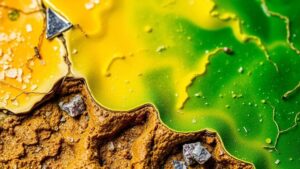The Role of Clay Deposits in Capturing and Retaining Gold
The Role of Clay Deposits in Capturing and Retaining Gold
Clay deposits play a significant role in the geological processes that enable the capture and retention of gold. Understanding these processes is essential for mining and geological research, particularly in regions where gold is naturally concentrated. This article examines the characteristics of clay deposits, their interactions with gold, and their implications for gold extraction and mining operations.
Understanding Clay Deposits
Clay is a fine-grained natural rock or soil material that contains clay minerals. e materials are formed through the weathering of rocks over long geological periods. The characteristics of clay deposits include:
- Small particle size
- Plasticity when wet
- Low permeability
- Cation exchange capacity
The unique properties of clay allow it to act as a natural adsorbent and provide environmental stability. These features are particularly crucial when considering their role in gold deposition.
Gold Occurrence and Clay Interaction
Gold is often found in association with various minerals and can be transported by water through alluvial deposits. As gold travels through sedimentary environments, it may come in contact with clay deposits. The interaction between gold particles and clay occurs under several conditions:
- Mechanical Capture: When gold particles are transported by water, they can become lodged in the porous structure of clay. This mechanical process helps in retaining gold within sediment layers.
- Chemical Adsorption: Clay’s high cation exchange capacity enables it to chemically bind gold ions. Certain clay minerals can facilitate the formation of gold complexes that are more stable than their aqueous counterparts.
Studies have indicated that clay minerals, such as montmorillonite and kaolinite, exhibit specific affinities for gold. For example, a research conducted in the Yilgarn Craton of Western Australia demonstrated that gold tends to accumulate in clay-rich horizons, contributing to significant gold deposits.
The Importance of Clay in Gold Mining
In the context of gold mining, the presence of clay significantly influences extraction techniques and efficiency. The impact includes:
- Modified Extraction Methods: The plasticity of wet clay challenges traditional mining techniques. Advanced methods, such as hydraulic mining, may be employed to handle clay-rich environments effectively.
- Environmental Considerations: Clay deposits play a crucial role in preventing the mobilization of metals and other pollutants. Their presence can mitigate the environmental impact of mining operations.
For example, in Nevada, the Carlin Trend deposits are known for their clay-rich formations that require specialized treatment processes for gold extraction, resulting in enhanced recovery rates.
Challenges Posed by Clay Deposits
While clay deposits can be beneficial in gold retention, they also present certain challenges that must be managed:
- Processing Difficulties: High clay content can complicate ore processing by making slurries difficult to manage in metallurgical processes.
- Water Management: The low permeability of clay can lead to water accumulation. Effective water management strategies are necessary to ensure operational efficiency.
In some cases, the presence of expansive clays can significantly impact the stability of tailings dams and waste rock facilities, necessitating enhanced engineering solutions.
Conclusion
To wrap up, the role of clay deposits in capturing and retaining gold is a multifaceted aspect of geology and mining that warrants attention. r mechanical and chemical interactions with gold facilitate its concentration and influence extraction methodologies. Understanding these processes not only improves mining efficiency but also supports sustainable practices in the industry.
As the demand for gold continues to grow, the mining industry must further explore innovative ways to leverage the unique properties of clay deposits to enhance gold recovery while minimizing environmental impacts, leading to a more sustainable future in mining.

